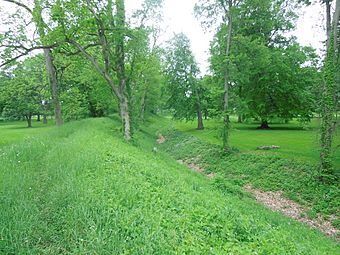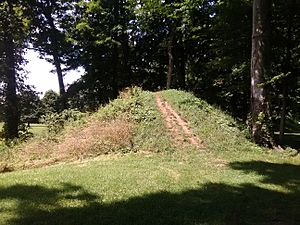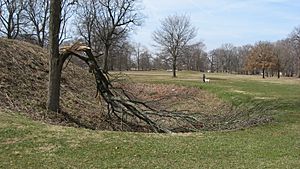Newark Earthworks facts for kids
|
Newark Earthworks
|
|

View along the main wall and the moat from the outside the Great Circle. The break in the wall - the traditional entrance - is visible in the far distance.
|
|
| Location | Roughly bounded by Union, 30th, James, and Waldo streets, and OH 16, Newark, Ohio |
|---|---|
| Area | 190 acres (77 ha) (landmarked area) |
| Architectural style | Hopewell culture |
| NRHP reference No. | 66000614 |
Quick facts for kids Significant dates |
|
| Added to NRHP | October 10, 1966 |
| Designated NHL | July 19, 1964 |
The Newark Earthworks are amazing ancient structures found in Newark and Heath, Ohio. They are made of earth and were built a very long time ago. This special place has three main parts: the Great Circle Earthworks, the Octagon Earthworks, and the Wright Earthworks.
These huge earthworks were built by the Hopewell culture. This was a group of Native American people who lived between 100 BCE and 400 CE. The Newark Earthworks contain the biggest earthen enclosures in the world. They once covered about 3,000 acres!
Today, only about 10 percent of the original site is still preserved. This preserved area is about 206 acres. The Octagon and Great Circle Earthworks are looked after by the Ohio History Connection. This site is so important that it's a National Historic Landmark. In 2006, it was even named the "official prehistoric monument of the State of Ohio."
The Newark Earthworks are part of a larger group called the Hopewell Ceremonial Earthworks. In 2008, the United States suggested these sites to UNESCO to become a World Heritage Site. This means they are considered very important to everyone on Earth.
Contents
History of the Earthworks
The Hopewell culture built these earthworks between 100 BCE and 400 CE. These places were used for many important things. Native Americans held ceremonies here and gathered socially. They also used the sites for trade, worship, and to honor their dead.
Scientists believe the Octagon earthwork had a special scientific purpose. It was likely used as a lunar observatory. This means people used it to track the moon's path in the sky. They could follow the moon's orbit over its 18.6-year cycle.
The Newark Earthwork site is the largest surviving Hopewell earthwork complex in North America. The Hopewell culture built many earthen mounds. Over many years, they created the biggest earthwork complex in the Ohio River Valley. These earthworks covered several square miles.
In the mid-1800s, two researchers named Ephraim G. Squier and Edwin Hamilton Davis studied these monuments. They mapped hundreds of ancient Native American sites for the Smithsonian Institution. Their detailed work helped start the study of archaeology in America.
Great Circle Earthworks
The Great Circle Earthworks are located in Heath, Ohio. They are about 1,200-foot (370 m) wide. This makes them one of the largest circular earthworks in the Americas. Building them took a huge amount of effort!
The Great Circle has a moat that is about 5-foot (1.5 m) deep. This moat is surrounded by walls that are about 8 feet (2.4 m) high. The entrance to the circle is even more grand.
Scientists have studied the way these earthworks are placed and lined up. This research shows that the ancient people who built them had advanced scientific knowledge. They used this knowledge to create these complex structures.
Octagon Earthworks
The Octagon Earthworks has three main parts. There's an Observatory Mound, an Observatory Circle (which is about 20 acres), and the Octagon itself (which is about 50 acres). The Octagon has eight walls, each about 550-foot (170 m) long. These walls are between 5 feet (1.5 m) and 6 feet (1.8 m) high. The Octagon is connected to the Observatory Circle by parallel walls.
In 1982, researchers discovered something amazing. They found that the Octagon Earthworks was a lunar observatory. It was built to track the moon's movements. This includes the moon's northernmost point in its 18.6-year cycle. When you stand on the observatory mound, the moon rises almost exactly in the center of the octagon during this special time.
This ancient observatory is incredibly precise. It is twice as accurate as Stonehenge, another famous ancient site.
For a while, from 1892 to 1908, the state of Ohio used the Octagon Earthworks as a military training camp. Later, a country club leased the land and turned it into a golf course.
Today, the Ohio History Connection manages the site. They have a lease with the Mound Builders Country Club until 2078. The country club helps maintain the land. However, some people believe a golf course is not the right use for such a sacred and important historical site. Many people want more public access to the earthworks. They want to be able to witness the moonrise, just as the original builders intended.
Wright Earthworks
The Wright Earthworks are a small part of what was once a huge square enclosure. They also include a piece of a wall that used to lead from the square to a large oval area. The original square was very precise. Its sides were about 940 feet (290 m) to 950 feet (290 m) long. It enclosed an area of about 20 acres (8.1 ha).
Sadly, much of this square and its mounds were destroyed. This happened in the 1800s as European-American settlers built things. The Ohio Canal was built, and the city of Newark grew with new streets and houses. Farmers also cleared fields for crops. All of this destroyed much of the ancient monument. Today, only a small part of one wall, less than 200 feet (61 m) long, remains.
The Wright Earthworks are named after Mrs. Frances Rees Wright. She generously donated this part of the site to the Ohio Historical Society in 1934.
Images for kids
















